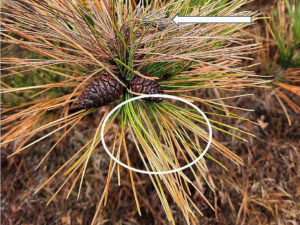
Hemlock needles affected by winter desiccation will start browning at the needle tips and move inward, sometimes killing the entire needle. / Photo Credit: Linda Williams, Wisconsin DNR
By Linda Williams, DNR Forest Health Specialist
Linda.Williams@wisconsin.gov or 920-360-0665
During the winter months, warm or sunny weather can wreak havoc on evergreen trees.
Conifers such as hemlock, pines and fir can lose moisture from their needles during the winter. If too much moisture is lost, those needles can quickly turn yellow or brown once the weather warms up in the spring.
Extensive browning of needles on hemlock — sometimes more than 50 percent of the needles – was observed in scattered areas of Oneida and Bayfield counties by the second week of April. The brown needles eventually dropped from the trees, leaving the remaining foliage looking very thin. Buds on the trees appeared viable, and the trees should break bud as normal.
Significant loss of needles can put trees under stress, so trees that were severely affected this year should be monitored over the next 1 to 3 years for possible mortality from Armillaria root disease, which can infect the roots of trees under stress.

A severely affected hemlock with more than 50 percent needle browning due to winter desiccation. / Photo Credit: Linda Williams, Wisconsin DNR
On a similar note, red pine in several north central Wisconsin counties quickly developed yellow-tan needles during the third week of April, following the warm-up this spring. The impacted needles are generally older and still have a green needle base, but most of the needle was yellow-tan, and later turned brown. Samples were collected to test for any fungal needle diseases. Results are still pending, but based on the timing of needle dieback, it is suspected that this is due to winter desiccation.
In scattered years over the past decade or two, red pine has experienced similar needle browning later in the growing season that was thought to be related to Diplodia infection or possibly other needle diseases. Test results in those situations were inconclusive. In those years, the needles also retained some green at the base of the needle and remained attached to the branches throughout the growing season.
When the brown needles remain in the crown, the entire red pine stand can appear darker, while the crowns look a bit thin because there is less green.
Generally, winter desiccation on conifers does not kill the tree but can cause crowns to appear thin until new needles expand this spring. Urban trees with winter desiccation may need to be watered if the weather is dry to alleviate stress caused by needle loss.
When trees experience dry fall weather and enter winter drier than preferred, the winter desiccation can be more severe. In future years, if fall weather is dry, be sure to water your trees right up until things freeze up.

Older red pine needles began to turn brown by the end of April due to winter desiccation. / Photo Credit: Linda Williams, Wisconsin DNR

Red pine needles (circled) have turned tan on the ends due to winter desiccation, but still have a green base. Above them (arrow), new growth from the previous year that died from Diplodia tip blight is totally brown. / Photo Credit: Linda Williams, Wisconsin DNR
